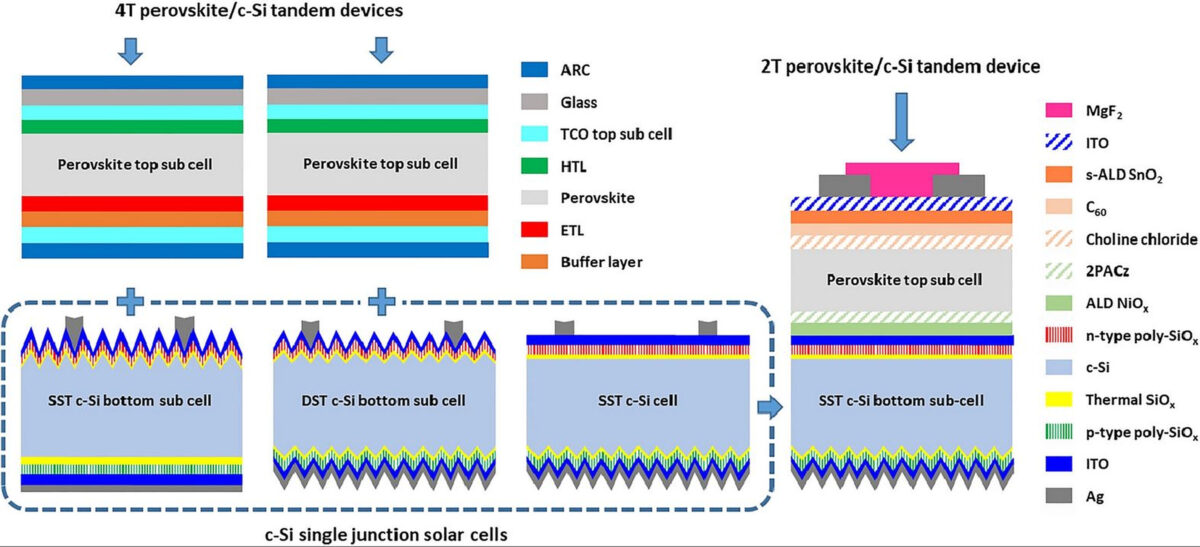A research group led by Delft University of Technology in the Netherlands has fabricated a crystalline silicon solar cell based on carrier-selective passivating contacts (CSPCs) made of polysilicon and silicon monoxide (poly-SiOx). They claim the tech could be used for four-terminal (4T) and two-terminal (2T) tandem perovskite silicon solar cells.
“Such CSPCs consist of doped poly-Si, alloyed with carbon or oxygen, which are deposited on an ultra-thin SiOx layer, prepared by a wet-chemical process, thermal oxidation, UV/O3 process, or low-temperature plasma oxidation,” the scientists said, in reference to the new passivating contacts. “The optoelectronic properties of poly-SiOx depend on the oxygen content.”
The scientists built the cell with a silicon dioxide (SiO2) layer deposited via plasma-enhanced chemical vapor deposition (PECVD). They also used n-type and p-type poly-SiOx passivating contacts, which they deposited on the thermal oxide with a dual-stack layer of 10-nm thick intrinsic amorphous silicon (a-Si) layer, via a low-pressure chemical vapor deposition (LPCVD) process, and a 20-nm thick hydrogenated a-SiOx layer from the PECVD process.
“Silane (SiH4), carbon dioxide (CO2), and hydrogen (H2) gases are used as the sources to deposit these poly-SiOx passivating contacts,” they said, in reference to the manufacturing process. “Phosphine (PH3) and diborane (B2H6) gases are used as doping sources for n-type and p-type poly-SiOx passivating contacts, respectively.”
The team also used screen printing to gear the cell with low-temperature front and rear Ag-based metallic contacts. The best solar cell built with this configuration and a p-type wafer achieved a power conversion efficiency of 20.47%, an open-circuit voltage of 95 mV, a short-circuit current of 36.68 mA/cm2, and a fill factor of 80.33%. The diffusivity of hydrogen in p-type poly-Si, on the other hand. is lower than in n-type, which prevents the accumulation of excess hydrogen around the oxide which deteriorates the passivation quality.
Popular content
When tested in tandem with a previously developed perovskite solar cell with an efficiency of 19.7%, the new cell respectively contributed to efficiencies of 28.1% and 23.2% in 4T and 2T cells.
The research group introduced its findings in “Crystalline silicon solar cells with thin poly-SiOx carrier-selective passivating contacts for perovskite/c-Si tandem applications,” which was recently published in Progress in Photovoltaics. The group includes academics from the Eindhoven University of Technology and the Netherlands Organisation for Applied Scientific Research (TNO).
The TNO is also now developing a four-junction (4T) semi-transparent perovskite-silicon tandem solar cell. It is working in partnership with the Solliance consortium, which includes Delft University of Technology, Eindhoven University of Technology, and Belgian research institute Imec. The device achieved a 30.1% power conversion efficiency in September.
A Dutch-German consortium led by the TNO is also trying to commercialize 2T perovskite-silicon tandem solar cell tech under FIT4Market, a four-year research project.
This content is protected by copyright and may not be reused. If you want to cooperate with us and would like to reuse some of our content, please contact: editors@pv-magazine.com.



1 comment
By submitting this form you agree to pv magazine using your data for the purposes of publishing your comment.
Your personal data will only be disclosed or otherwise transmitted to third parties for the purposes of spam filtering or if this is necessary for technical maintenance of the website. Any other transfer to third parties will not take place unless this is justified on the basis of applicable data protection regulations or if pv magazine is legally obliged to do so.
You may revoke this consent at any time with effect for the future, in which case your personal data will be deleted immediately. Otherwise, your data will be deleted if pv magazine has processed your request or the purpose of data storage is fulfilled.
Further information on data privacy can be found in our Data Protection Policy.